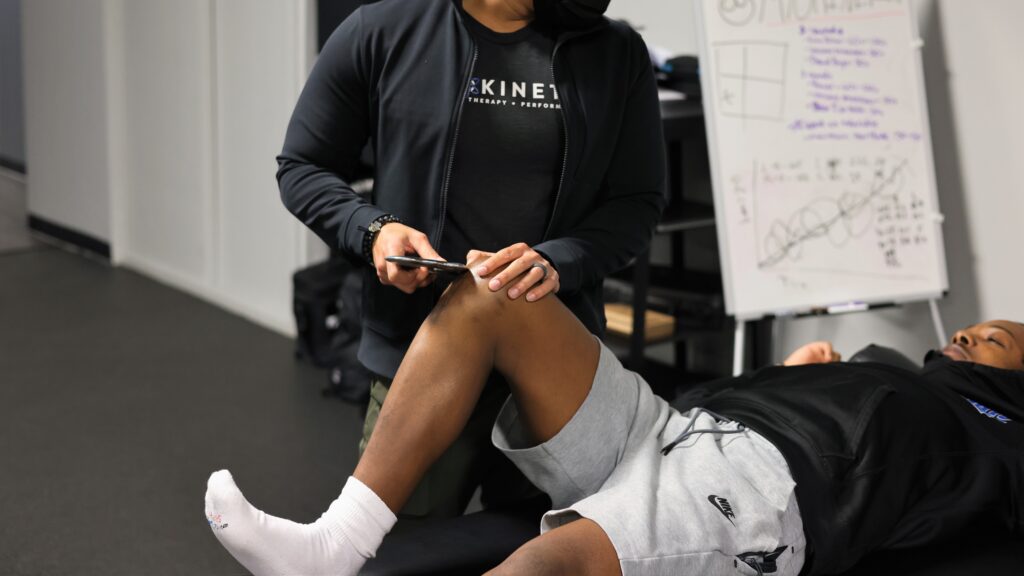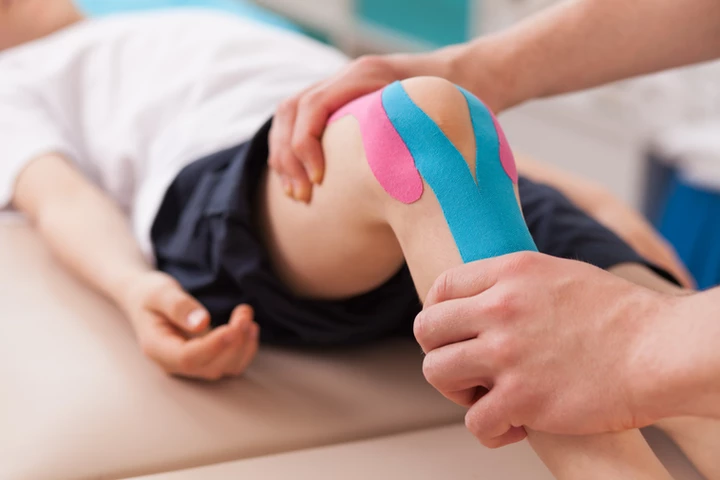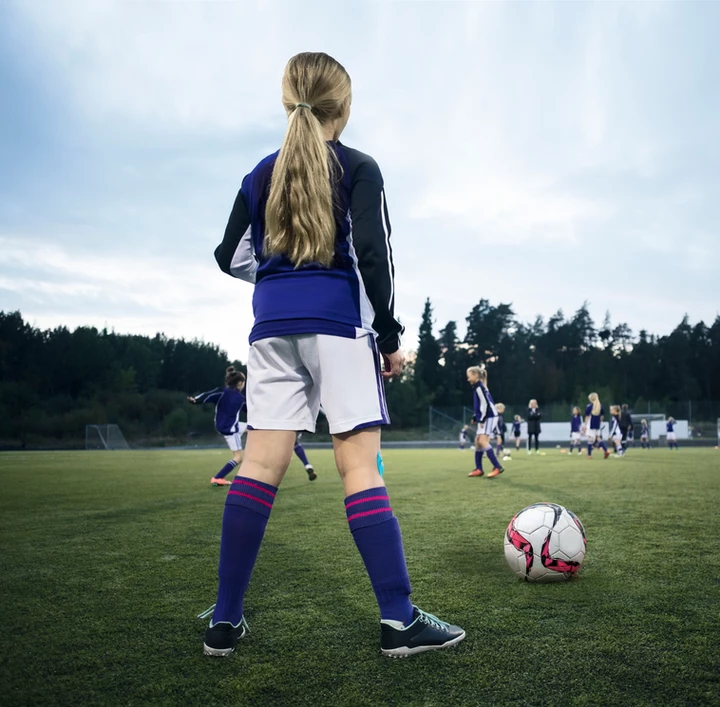- How recovery from an ACL tear in baseball and softball can be a long road, with surgery and rehab taking months and resulting in missed games and frustration.
- Why advances in medicine have made it possible to recover from ACL tears, but there is no standard timeline for return to play.
- What three key factors to asses when considering to return to play after an ACL tear and the testing process to determine readiness for sports activities.

Hearing about a player who suffered an ACL tear is tough. Watching your own child go through it can feel downright impossible.
From the injury to surgery to rehab, there’s no denying that recovery from an ACL tear is a long road. Recovery can take months and result in missed games, frustration, and a ton of tears.
As the parent, it’s natural to wonder, “how long will it be until my kid is back on the field?”. And, unfortunately, there’s no standard answer for this.
But, luckily, advances in medicine have made it possible to all but rule out the words “career-ending” when describing ACL tears. So, if your child is suffering from an ACL injury, then don’t worry. Recovery will take some time, but it is possible to safely get back to playing.
But, before we get there, let’s take a moment to share why recovery takes so long. There are some important facts that parents should know about returning to play after an ACL tear.
Understanding Key Facts About the ACL (Anterior Cruciate Ligament)
Nearly 250,000 athletes suffer from an ACL injury every year. This makes ACL tears one of the most common knee injuries in sports. What’s even scarier is that 25% of these injured athletes will go on to suffer another ACL tear in the future.
These statistics make you wonder why ACL injuries are so prevalent. And, obviously, what can be done to prevent them from happening to your child.
How does an ACL injury occur?
The ACL, Anterior Cruciate Ligament, is most commonly injured while performing quick deceleration or acceleration movements. Common movements such as cutting away from an opponent or jumping in the air. When an ACL injury occurs, athletes frequently hear a “pop,” followed by the feeling of their knee giving out.
Interestingly, only 30% of ACL tears are actually caused by physical contact with another player. This tells us that the ACL is highly vulnerable to injury. Even without contact it’s vulnerable, which might be explained by its location within the knee joint itself.
The knee is stabilized by four primary ligaments that act like ropes to hold the knee joint together. The ACL is located inside the joint and controls the back and forth motion as well as rotation. Too much rotation or forward/backward movement can cause an ACL rupture. This severely limits the control and stability at the knee. This is why you’ll hear athletes mention that it felt like their knee gave out after the injury occurred.
What You Should Know About ACL Surgery
It’s a well-known fact that many athletes who suffer from a torn ACL will eventually have ACL surgery and reconstruction.
Take some time to discuss the recovery process with your son or daughter’s surgeon before going through with surgery. Research has shown that, oftentimes, expectations for recovery do not always match the outcomes after ACL surgery. Talk through this with your child, and make sure both of you fully understand the process. Set realistic expectations for the tough months to follow.
Is It Possible to Prevent an ACL Tear?
Other than completely sidelining your child from sports, the answer is no.
On the other hand, while we can never fully prevent injuries from occurring, your child’s medical team will do their best to reduce the risk of re-injury, which is crucial when it comes time to talk about returning to play after an ACL tear.
How do we know when an individual is ready to return to sport after ACL rupture?
The risk of re-injury is alarmingly high. Some sources estimate as many as 25% of athletes younger than age 25 will suffer from another ACL injury to the same or opposite leg. Athletes who go back to play sooner than nine months after ACL surgery are 7x more likely to reinjure the same leg.
But, while this statistic is frightening to consider, take comfort in knowing that the risk for reinjury significantly drops for athletes who are out for more than nine months after an ACL tear.
Many experts have tried to find ways to lessen the reinjury rate and standardize the rehabilitation process. But, to date, no one has been able to agree on the best course of action for athletes recovering from ACL ruptures. Part of the difficulty in standardizing this process is due to the fact that there are significant gender and age differences, as well as differences in sport demands, that will affect your child’s recovery process.
Despite this, experts agree that there is a certain list of criteria that athletes should meet in order to be considered for return to play after an ACL tear. These considerations are carefully weighed by your child’s care team, including the surgeon, athletic trainers, physical therapists, coaching staff, and, most importantly, you and your child. The next section will review three ways to tell if your child is ready to play after an ACL tear.
3 Ways to Tell If Your Kid Is Ready to Play After an ACL Tear
1. Has your child had enough time to recover from surgery?
Like we stated earlier, going back earlier than 9 months significantly increases your child’s risk of reinjury or suffering an ACL tear on the other leg. Because of this risk, experts recommend waiting until your child has had at least 12 months to recover from ACL surgery. Doing so can lower his/her risk for re-injury by 51%.

2. Is your child PHYSICALLY ready to play again after an ACL tear?
Historically, physical readiness has been a main focus in determining whether or not an athlete is ready to return to play after an ACL tear. And it’s been this way for a good reason.
Testing your child’s lower body strength is a crucial part of the return-to-play process after an ACL tear. Ideally, the injured leg should be just as strong as the non-injured leg. At the absolute minimum, the difference between both legs should be less than or equal to 10%.
Another key factor to determine physical readiness is frequently referred to as the quad-to-hamstring ratio. This describes the strength of the quadriceps in relation to the hamstrings, which is important for the stability of the knee joint. The quad-to-hamstring ratio should be 80% in order to protect the ACL and prevent further injury.
Your child may also be asked to do something called the Hop Test which looks at balance, stability, and power generation in the lower body. Both legs should be tested with less than a 10% difference between the two sides to indicate a normal test result.
3. Is your child mentally ready to perform in the game?
Although your child may pass the physical tests with flying colors, he or she may not be mentally ready to go back in the game yet.
It’s important for you to realize that your child may harbor feelings of stress, anxiety, or fear about returning to the sport that caused the injury. There is a possibility that, when left unaddressed, these feelings can evolve into fear-avoidance behaviors.
Fear-avoidance behaviors describe the way in which people avoid activities that they once enjoyed out of fear of a negative outcome. Furthermore, these behaviors are associated with poor performance despite being physically capable of doing well during practice or games.
Regardless of whether your athlete is experiencing mild apprehension or severe fear-avoidance behaviors, the mental effects of returning to play should be addressed in everyone. Therefore, don’t be surprised if the physical therapist or doctor asks your child to complete a questionnaire to determine whether your child feels mentally ready to return.
Takeaway points
Over the past few decades, there’s been a need to create a standard of care for returning kids back to sports after an ACL injury. While the jury is still out, there are some general guidelines to follow when making this decision.
After ACL surgery, it is of the utmost importance to allow the full healing process to take place before returning to any structured training activity. Thanks to the research, we know that this process takes at least 9 to 12 months. This is especially important when it comes to lowering the risk for re-injury or another ACL tear.

When your child finally shows signs of readiness to return back to the field, there are several tests that they will need to pass. These tests will ensure that your child is physically and mentally ready with the lowest possible risk for reinjury.
As a parent, you should realize that the rate of reinjury after an ACL tear is high. An early return-to-sport may not be the right thing to do. We at Myokinetix believe that more information is better when it comes to testing for your child’s readiness. We are more than equipped to answer the hard questions during ACL rehabilitation.
Our ACL Return-to-Sport program is a holistic treatment approach to your child’s recovery. We use a multi-step return-to-sport testing process that fully assesses your child’s readiness to play. That way, you can be confident in knowing that they are truly safe to return to the field. Interested in learning more? Click here to visit our website on ACL Rehabilitation and to read about our program offerings.

It is visible, not destiny.